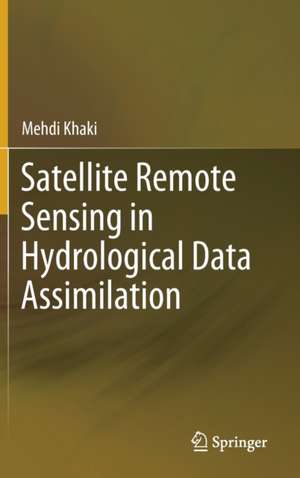Satellite Remote Sensing in Hydrological Data Assimilation
Autor Mehdi Khakien Limba Engleză Hardback – 4 ian 2020
This book presents the fundamentals of data assimilation and reviews the application of satellite remote sensing in hydrological data assimilation. Although hydrological models are valuable tools to monitor and understand global and regional water cycles, they are subject to various sources of errors. Satellite remote sensing data provides a great opportunity to improve the performance of models through data assimilation.
Preț: 787.78 lei
Preț vechi: 960.71 lei
-18% Nou
Puncte Express: 1182
Preț estimativ în valută:
150.79€ • 163.85$ • 126.74£
150.79€ • 163.85$ • 126.74£
Carte tipărită la comandă
Livrare economică 21 aprilie-05 mai
Preluare comenzi: 021 569.72.76
Specificații
ISBN-13: 9783030373740
ISBN-10: 3030373746
Ilustrații: XV, 290 p. 101 illus., 88 illus. in color.
Dimensiuni: 155 x 235 mm
Greutate: 0.61 kg
Ediția:1st ed. 2020
Editura: Springer International Publishing
Colecția Springer
Locul publicării:Cham, Switzerland
ISBN-10: 3030373746
Ilustrații: XV, 290 p. 101 illus., 88 illus. in color.
Dimensiuni: 155 x 235 mm
Greutate: 0.61 kg
Ediția:1st ed. 2020
Editura: Springer International Publishing
Colecția Springer
Locul publicării:Cham, Switzerland
Cuprins
Part 1: Hydrological Data Assimilation.- Chapter 1 - Introduction.- Chapter 2 - Data assimilation and remote sensing data.- Part 2: Model-Data.- Chapter 3 - Hydrologic model.- Chapter 4 - Remote sensing for assimilation.- Part 3 : Data Assimilation Filters.- Chapter 5 - Sequential Data Assimilation Techniques for Data Assimilation.- Part 4 : GRACE Data Assimilation.- Chapter 6 - Efficient Assimilation of GRACE TWS into Hydrological Models.- Part 5 : Water Budget Constraint.- Chapter 7 - Constrained Data Assimilation Filtering.- Chapter 8 - Unsupervised Constraint for Hydrologic Data Assimilation.- Part 6 : Data-driven Approach.- Chapter 9 - Non-parametric Hydrologic Data Assimilation.- Chapter 10 - Parametric and Non-parametric Data Assimilation Frameworks.- Part 7 Hydrologic Applications.- Chapter 11- Groundwater Depletion over Iran.- Chapter 12 - Water Storage Variations over Bangladesh.- Chapter 13 - Multi-mission Satellite Data Assimilation over South America.
Notă biografică
Dr. Mehdi Khaki received his Bachelor of Civil Engineering in Surveying from the University of Tehran (Iran) in 2011. He also holds an M.Sc. in Geodesy from the same institute (2014), and a PhD in Spatial Sciences from Curtin University (Australia). In 2018, he started working as a lecturer at the School of Engineering, at the University of Newcastle (Australia). Mehdi’s research focuses on the application of geodetic and remote sensing techniques and their integration with hydrological models to improve their simulations in various spatial scales. He has developed new satellite data filtering techniques to improve their quality and also new data assimilation methods for integrating multiple satellite-derived measurements, e.g. satellite gravity and soil moisture measurements with hydrologic models. Using these he was able to analyse water storage and its variations, as well as its connection with the anthropogenic and climatic impacts in various parts of the world,such as Australia, Iran, Bangladesh, South America and Africa.
Textul de pe ultima copertă
This book presents the fundamentals of data assimilation and reviews the application of satellite remote sensing in hydrological data assimilation. Although hydrological models are valuable tools to monitor and understand global and regional water cycles, they are subject to various sources of errors. Satellite remote sensing data provides a great opportunity to improve the performance of models through data assimilation.
Caracteristici
Is the first independent book in hydrological data assimilation Written in a highly scientific but easy to follow style Benefits researchers in the fields of hydrology, remote sensing and data assimilation Introduces the commonly used filters step by step Includes multiple real-world applications of data assimilation in hydrology
